Design and Characteristic Analysis of a Homopolar Synchronous Machine Using a NI HTS Field Coil
Abstract
:1. Introduction
2. Characteristic Resistances of the HTS Coils According to the Winding Method
3. HTS Homopolar Synchronous Machine
3.1. Machine Structure and Operating Principle of the HTS HSM
3.2. Simulation Model of the HTS HSM Using the NI HTS Field Coil
3.3. Results and Discussion
4. Conclusions
Funding
Conflicts of Interest
Nomenclature
| Yield strength | |
| v | Poisson’s ratio |
| ρ | Density of rotor material |
| n0 | The number of armature conductors per slot |
| I0 | Total current per slot |
| r | Outer radius of rotor |
| l | Effective length of rotor |
| Ω | Mechanical angular speed |
| E | Young’s modulus |
| k | Safety factor |
| SCu | Cross-sectional area of armature conductor |
| JCu | The allowable current density of armature conductor |
| yj | Slot height |
| wslot | Slot width |
| β | Packing factor |
| σFtan | Tangential stress of rotor |
| IS | RMS value of phase current |
| q | The number of slots |
| cos φ | Power factor |
| ρcl | Electrical resistivity of the current lead |
| lcl | Length of the current lead |
| I | Transport current through the current lead |
| Scl | Cross-sectional area of the current lead |
| kcl | Thermal conductivity of the current lead |
| Th | Temperature at the high-temperature part |
| Tl | Temperature at the low-temperature part |
| σ | Stefan–Boltzmann constant (5.67 × 10−8 W·m−2·K−4) |
| εh | Emissivity of the vessel |
| εN | Emissivity of MLI |
| N | No. of MLI layers |
| Sh | Surface area of the high-temperature part |
| Sl | Surface area of the low-temperature part |
| Al | Cross-sectional area of a signal line or a leading-in tube |
| kl | Thermal conductivity of a signal line or a leading-in tube |
| Ll | Length of a signal line or a leading-in tube |
References
- Kim, Y.-G.; Hahn, S.; Kim, K.L.; Kwon, O.J.; Lee, H. Investigation of HTS racetrack coil without turn-to-turn insulation for superconducting rotating machines. IEEE Trans. Appl. Supercond. 2011, 22, 5200604. [Google Scholar]
- Bang, J.; Kim, S.; Jang, J.Y.; Hwang, Y.J.; Cho, M.; Kim, J.; Lee, J.T.; Ahn, M.C.; Lee, S.; Hahn, S. Field Measurement and Analysis of a 3 T 66 mm No-Insulation HTS NMR Magnet With Screening Current and Manufacturing Uncertainty Considered. IEEE Trans. Appl. Supercond. 2019, 29, 4601305. [Google Scholar] [CrossRef]
- Quddes, M.R.; Sekino, M.; Ohsaki, H.; Kashima, N.; Nagaya, S. Electromagnetic Design Study of Transverse Flux Enhanced Type Superconducting Wind Turbine Generators. IEEE Trans. Appl. Supercond. 2011, 21, 1101–1104. [Google Scholar] [CrossRef]
- Fukui, S.; Ogawa, J.; Sato, T.; Tsukamoto, O.; Kashima, N.; Nagaya, S. Study of 10 MW-Class Wind Turbine Synchronous Generators with HTS Field Windings. IEEE Trans. Appl. Supercond. 2011, 21, 1151–1154. [Google Scholar] [CrossRef]
- Kim, J.M.; Jang, J.Y.; Lee, S.; Hwang, Y.J. Characteristic analysis of an HTS flux-switching synchronous generator with NI-type HTS field coils. IEEE Trans. Appl. Supercond. 2018, 28, 5202705. [Google Scholar] [CrossRef]
- Li, W.; Ching, T.W.; Chau, K.T.; Lee, C.H.T. A Superconducting Vernier Motor for Electric Ship Propulsion. IEEE Trans. Appl. Supercond. 2018, 28, 5201706. [Google Scholar] [CrossRef]
- Wang, Y.; Wang, C.; Feng, Q.; Li, X.; Ching, T.W. Design and Experiment of an HTS Flux-Switching Machine with Stationary Seal. IEEE Trans. Appl. Supercond. 2017, 27, 5201405. [Google Scholar] [CrossRef]
- Kim, J.M.; Jang, J.Y.; Chung, J.; Hwang, Y.J. A New Outer-Rotor Hybrid-Excited Flux-Switching Machine Employing the HTS Homopolar Topology. Energies 2019, 12, 2654. [Google Scholar] [CrossRef] [Green Version]
- Hwang, Y.J.; Jang, J.Y.; Jeon, H. Overhang effect analysis of a homopolar HTS synchronous generator using 3D finite element method. IEEE Trans. Appl. Supercond. 2010, 30, 5202105. [Google Scholar] [CrossRef]
- Lee, C.Y.; Lee, J.H.; Park, C.B.; Ryu, W.H.; Chung, Y.D.; Hwang, Y.J.; Ko, T.K.; Oh, S.-Y.; Lee, J. Conceptual design of superconducting linear synchronous motor for 600-km/h wheel-type railway. IEEE Trans. Appl. Supercond. 2013, 24, 3600304. [Google Scholar] [CrossRef]
- Torrey, D.; Parizh, M.; Bray, J.; Stautner, W.; Tapadia, N.; Xu, M.; Wu, A.; Zierer, J. Superconducting Synchronous Motors for Electric Ship Propulsion. IEEE Trans. Appl. Supercond. 2020, 30, 5204708. [Google Scholar] [CrossRef]
- Haran, K.S.; Kalsi, S.; Arndt, T.; Karmaker, H.; Badcock, R.; Buckley, B.; Haugan, T.; Izumi, M.; Loder, D.; Bray, J.W.; et al. High power density superconducting rotating machines-development status and technology roadmap. Supercond. Sci. Technol. 2017, 30, 123002. [Google Scholar] [CrossRef]
- Takematsu, T.; Hu, R.; Yanagisawa, Y.; Nakagome, H.; Uglietti, D.; Kiyoshi, T.; Takahashi, M.; Maeda, H. Degradation of the performance of a YBCO-coated conductor double pancake coil due to epoxy impregnation. Phys. C 2010, 470, 674–677. [Google Scholar] [CrossRef] [Green Version]
- Hwang, Y.J.; Jang, J.Y.; Song, S.; Kim, J.M.; Lee, S. Feasibility Study of the Impregnation of a No-Insulation HTS Coil Using an Electrically Conductive Epoxy. IEEE Trans. Appl. Supercond. 2017, 27, 4603405. [Google Scholar] [CrossRef]
- Sivasubramaniam, K.; Laskaris, E.T.; Shah, M.R.; Bray, J.W.; Garrigan, N.R. High-Temperature Superconducting Homopolar Inductor Alternator for Marine Applications. IEEE Trans. Appl. Supercond. 2008, 18, 1–6. [Google Scholar] [CrossRef]
- Hwang, Y.J.; Choi, S.; Jang, J.Y.; Lee, J.; Yoon, Y.S.; Kim, H.M.; Chung, Y.D.; Jo, Y.-S.; Jang, M.H.; Al-Ammar, E.A.; et al. A study on the superconducting synchronous generator with the fixed-type field coil. IEEE Trans. Appl. Supercond. 2012, 23, 5200305. [Google Scholar] [CrossRef]
- Choi, S.; Jo, H.C.; Hwang, Y.J.; Hahn, S.; Ko, T.K. A Study on the No Insulation Winding Method of the HTS Coil. IEEE Trans. Appl. Supercond. 2012, 22, 4904004. [Google Scholar] [CrossRef]
- Kim, K.; Kim, K.; Bhattarai, K.; Radcliff, K.; Jang, J.Y.; Hwang, Y.J.; Lee, S.; Yoon, S.; Hahn, S. Quench behavior of a no-insulation coil wound with stainless steel cladding REBCO tape at 4.2 K. Supercond. Sci. Technol. 2017, 30, 075001. [Google Scholar] [CrossRef]
- Lee, T.S.; Hwang, Y.J.; Lee, J.; Lee, W.S.; Kim, J.; Song, S.; Ahn, M.C.; Ko, T.K. The effects of co-wound Kapton, stainless steel and copper, in comparison with no insulation, on the time constant and stability of GdBCO pancake coils. Supercond. Sci. Technol. 2011, 22, 4904004. [Google Scholar]
- Kim, K.; Bhattarai, K.R.; Jang, J.Y.; Hwang, Y.J.; Kim, K.; Yoon, S.; Lee, S.; Hahn, S. Design and performance estimation of a 35 T 40 mm no-insulation all-REBCO user magnet. Supercond. Sci. Technol. 2017, 30, 065008. [Google Scholar] [CrossRef]
- Hahn, S.; Park, D.K.; Bascuan, J.; Iwasa, Y. HTS pancake coils without turn-to-turn insulation. IEEE Trans. App. Supercond. 2011, 21, 1592–1595. [Google Scholar] [CrossRef]
- Wang, X.; Haha, S.; Kim, Y.; Bascuan, J.; Voccio, J.; Lee, H.; Iwasa, Y. Turn-to-turn contact characteristics for an equivalent circuit model of no-insulation ReBCO pancake coil. Supercond. Sci. Technol. 2013, 26, 035012. [Google Scholar] [CrossRef] [PubMed]
- Hwang, Y.J.; Ahn, M.C.; Lee, T.S.; Lee, W.S.; Ko, T.K. Experimental study of the effects of alternating fields on HTS coils according to the winding insulation conditions. Supercond. Sci. Technol. 2013, 26, 085021. [Google Scholar] [CrossRef]
- Song, J.-B.; Hahn, S.; Kim, Y.; Miyagi, D.; Voccio, J.; Bascuan, J.; Lee, H.; Iwasa, Y. Dynamic Response of No-Insulation and Partial-Insulation Coils for HTS Wind Power Generator. IEEE Trans. Appl. Supercond. 2015, 25, 5202905. [Google Scholar] [CrossRef]
- Hahn, S.; Kim, K.; Kim, K.; Lee, H.; Iwasa, Y. Current Status of and Challenges for No-Insulation HTS Winding Technique. J. Cryog. Supercond. Soc. Jpn. 2018, 53, 2–9. [Google Scholar] [CrossRef] [PubMed] [Green Version]
- Zhang, Z.; Kim, C.H.; Kim, J.G.; Kvitkovic, J.; Pamidi, S.; Zhang, M.; Li, J.; Yuan, W. An Experimental Investigation of the Transient Response of HTS Non-insulation Coil. J. Supercond. Nov. Magn. 2017, 20, 387–393. [Google Scholar] [CrossRef] [Green Version]
- Wang, T.; Noguchi, S.; Wang, X.; Arakawa, I.; Minami, K.; Monma, K.; Ishiyama, A.; Hahn, S.; Iwasa, Y. Analyses of Transient Behaviors of No-Insulation REBCO Pancake Coils During Sudden Discharging and Overcurrent. IEEE Trans. Appl. Supercond. 2015, 25, 4603409. [Google Scholar] [CrossRef]
- Jang, J.Y.; Yoon, S.; Hahn, S.; Hwang, Y.J.; Kim, J.; Shin, K.H.; Cheon, K.; Kim, K.; In, S.; Hong, Y.-J.; et al. Design, construction and 13 K conduction-cooled operation of a 3 T 100 mm stainless steel cladding all-REBCO magnet. Supercond. Sci. Technol. 2017, 30, 105012. [Google Scholar] [CrossRef] [Green Version]
- Hwang, Y.J.; Jang, J.Y.; Lee, S. A Flux-Controllable NI HTS Flux-Switching Machine for Electric Vehicle Applications. Appl. Sci. 2020, 10, 1564. [Google Scholar] [CrossRef] [Green Version]
- Zhang, G.; Hua, W.; Cheng, M.; Liao, J.; Wang, K.; Zhang, J. Investigation of an Improved Hybrid-Excitation Flux-Switching Brushless Machine for HEV/EV Applications. IEEE Trans. Ind. Appl. 2015, 51, 3791–3799. [Google Scholar] [CrossRef]


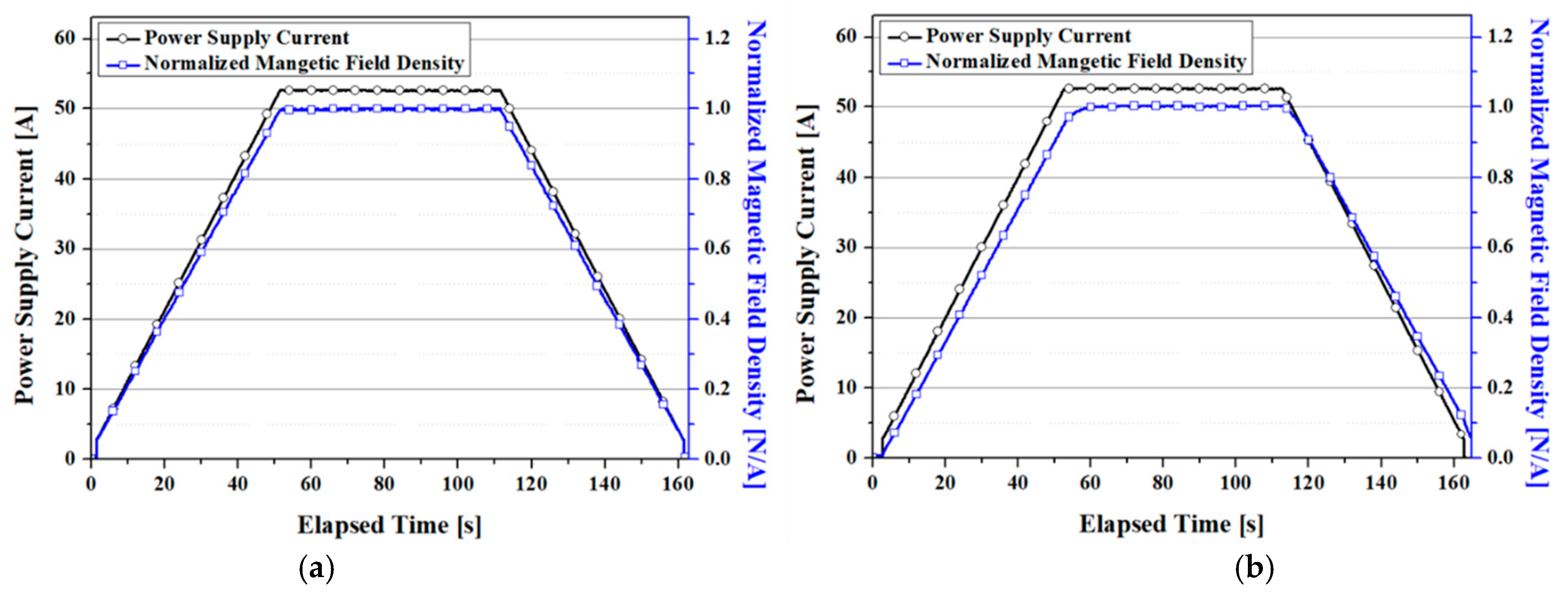




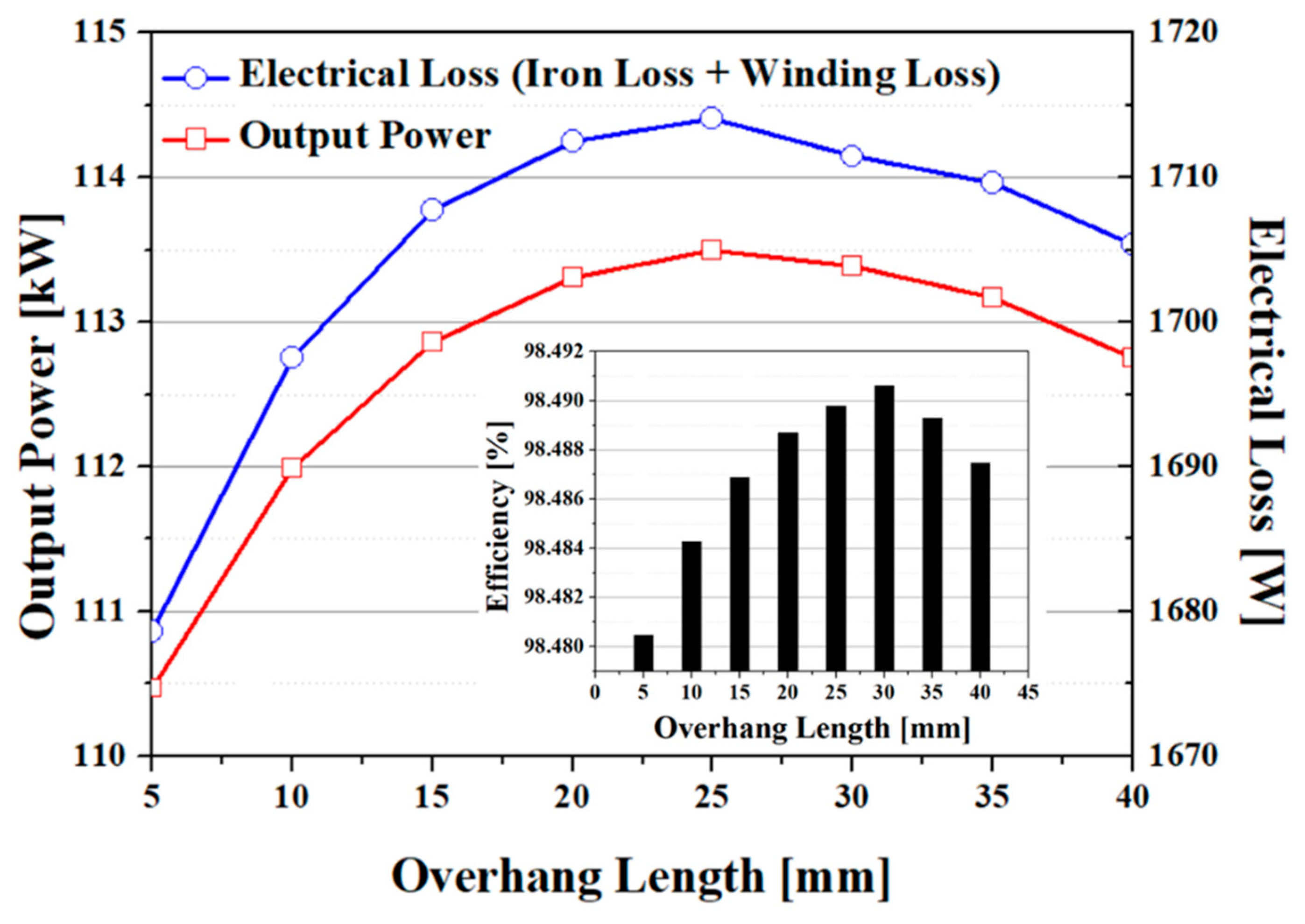

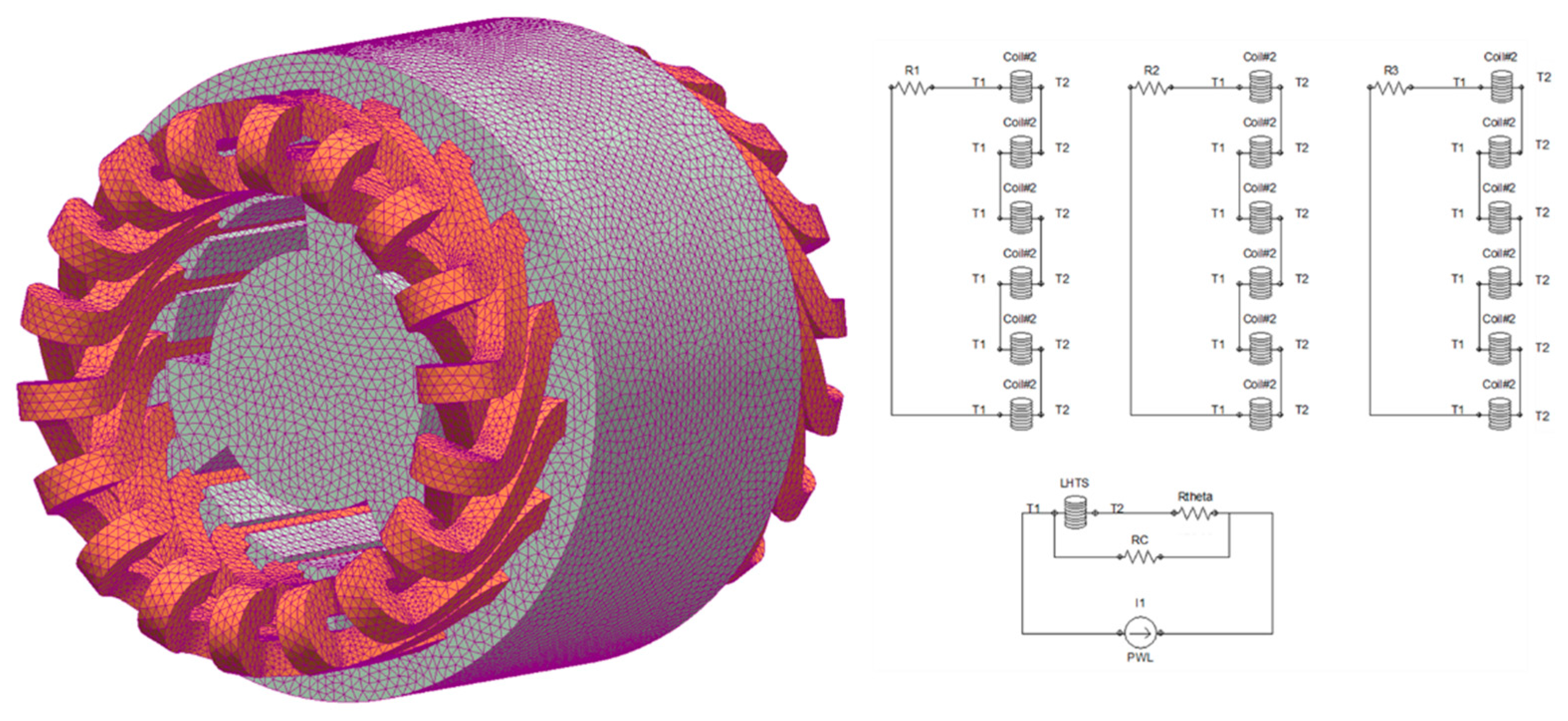
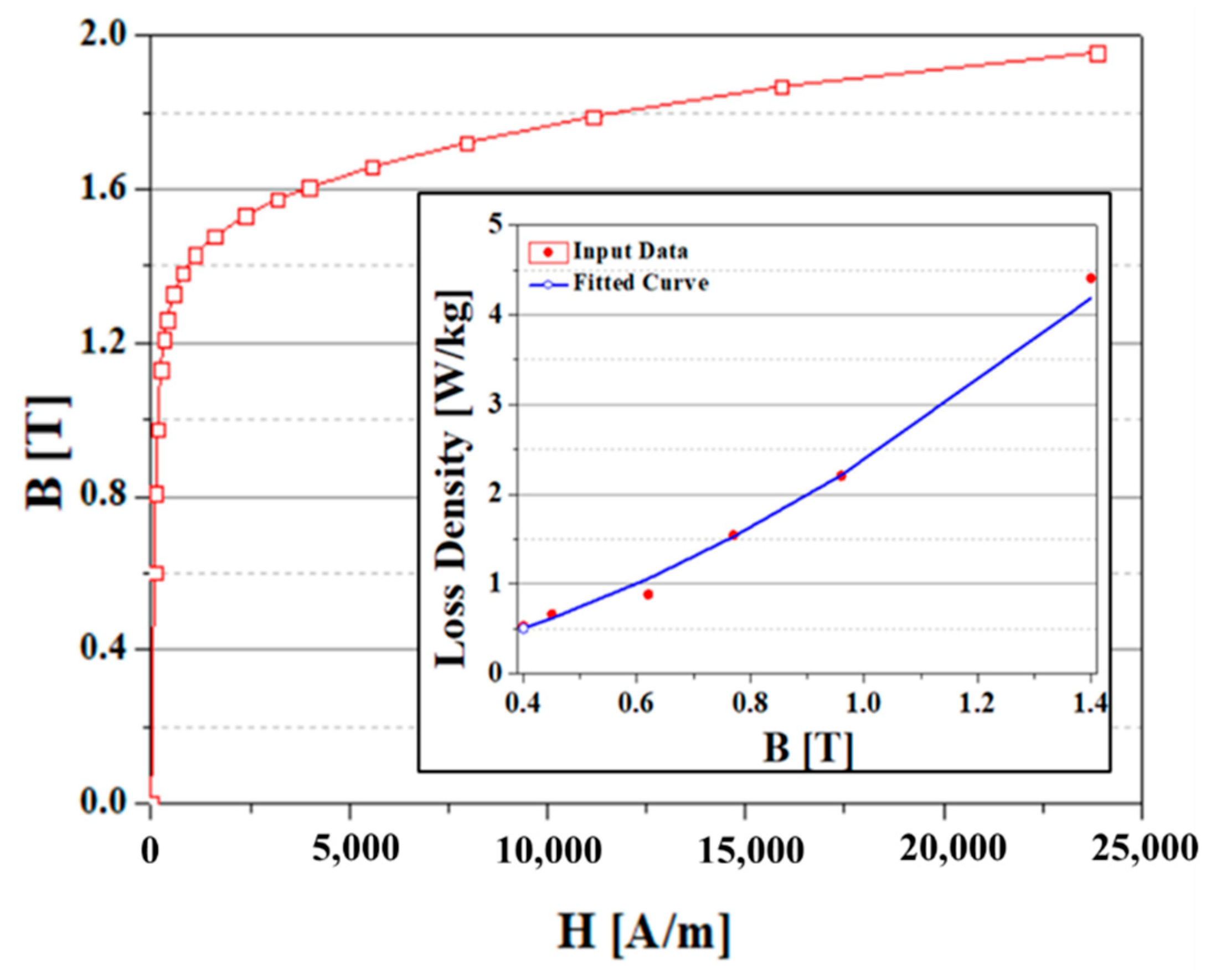

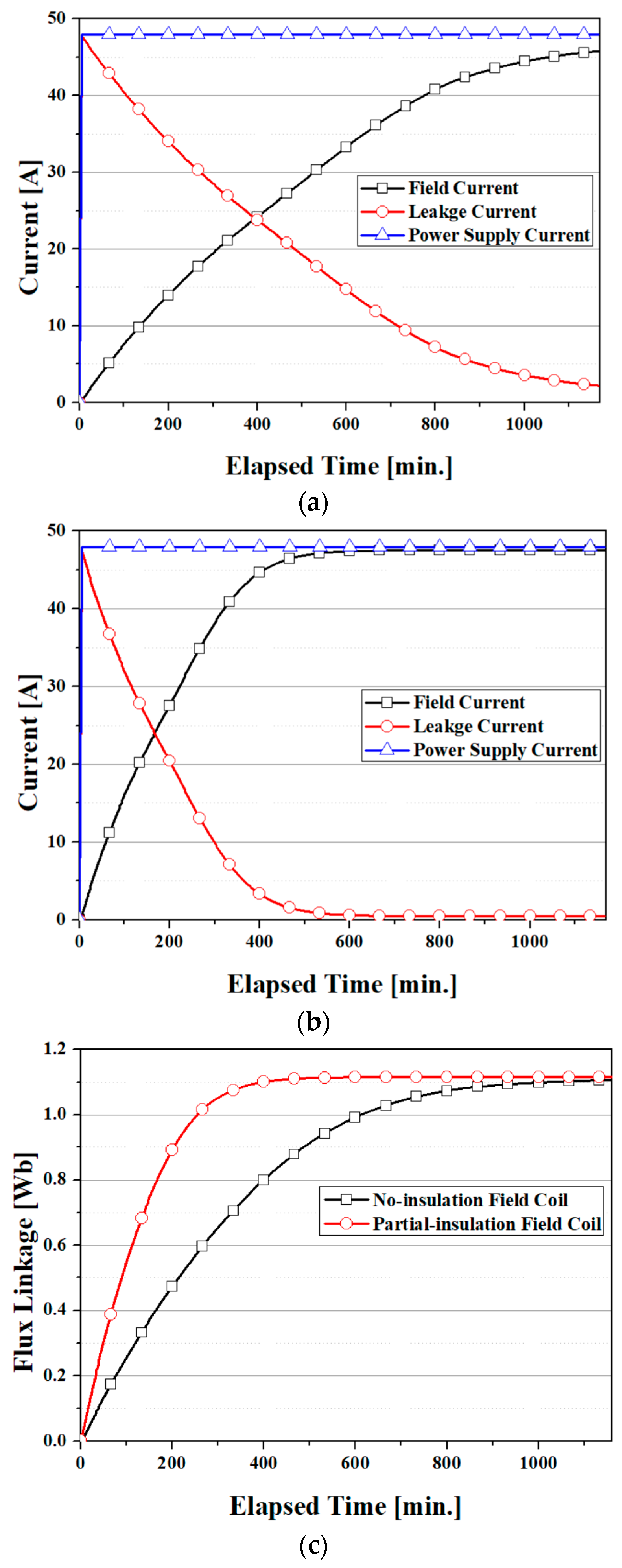
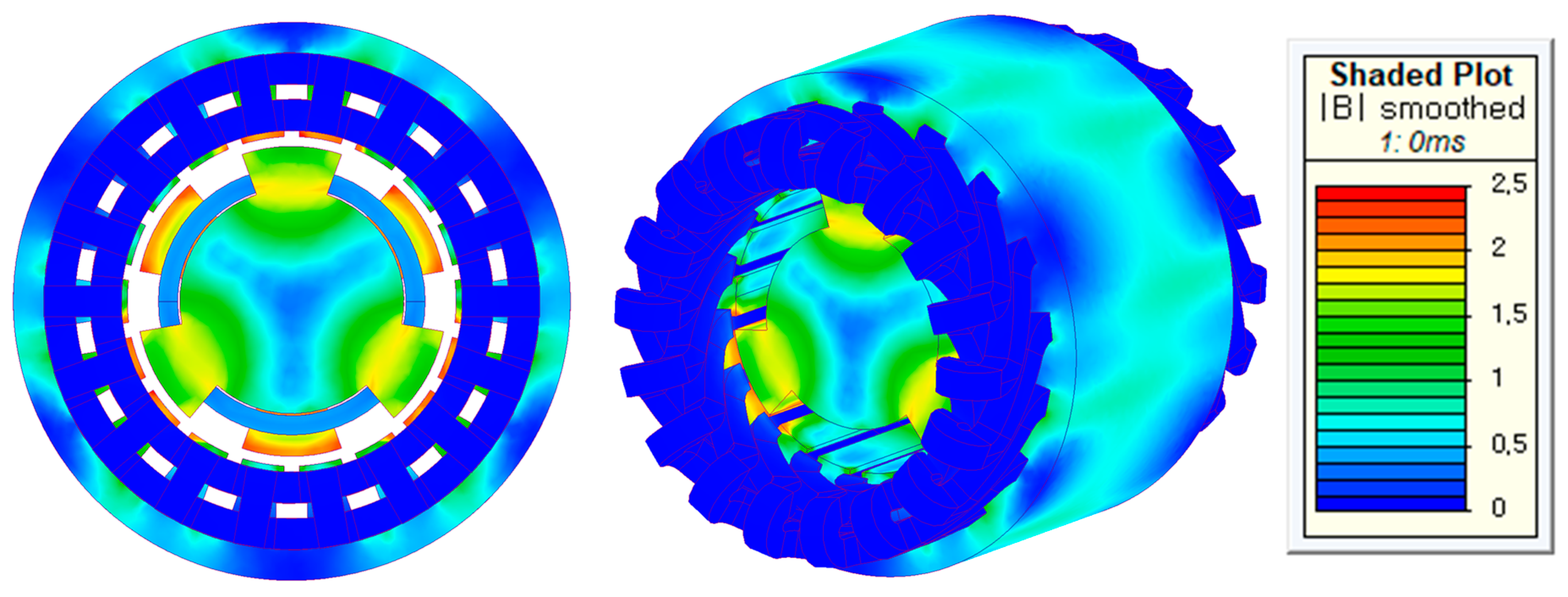
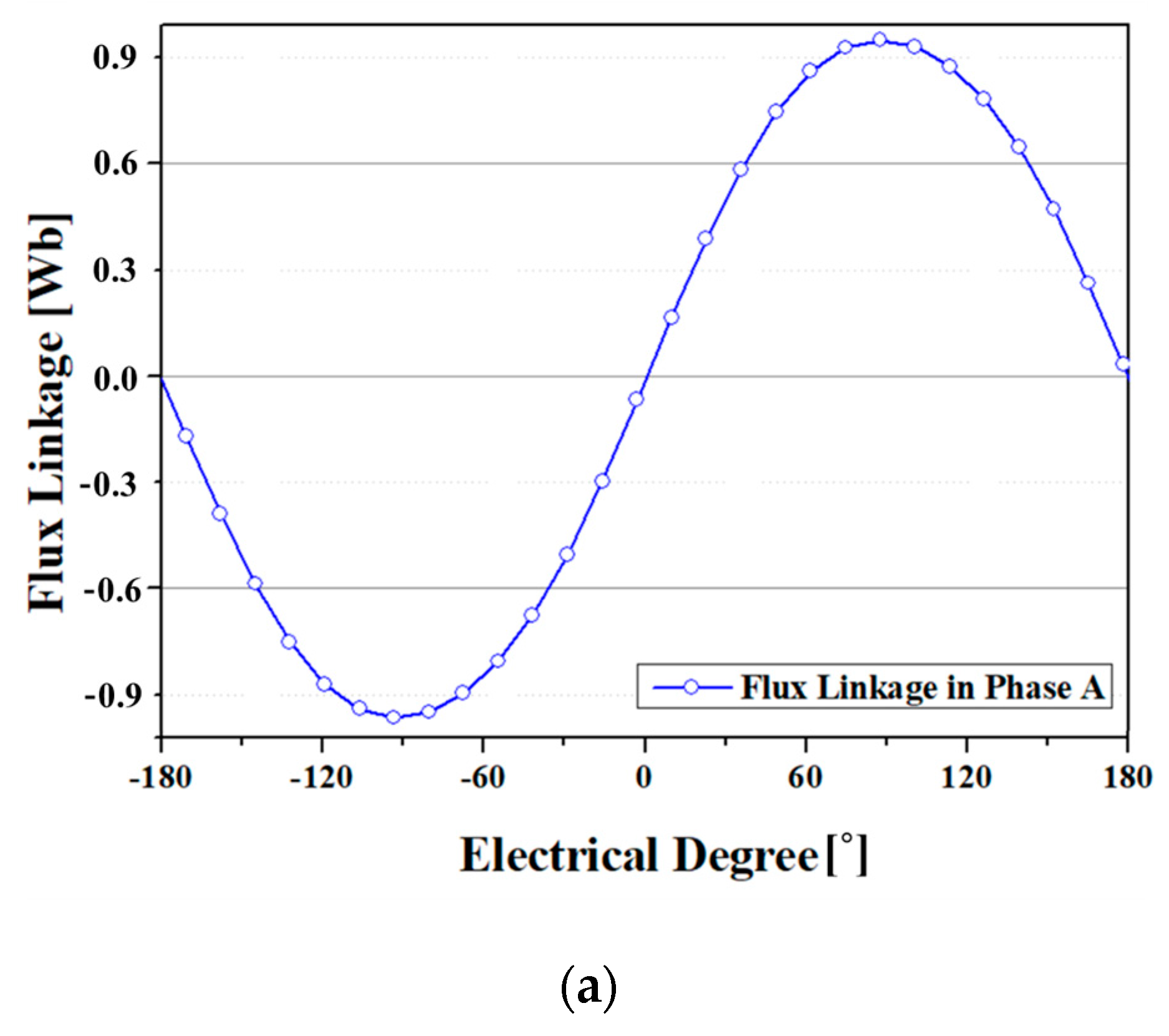
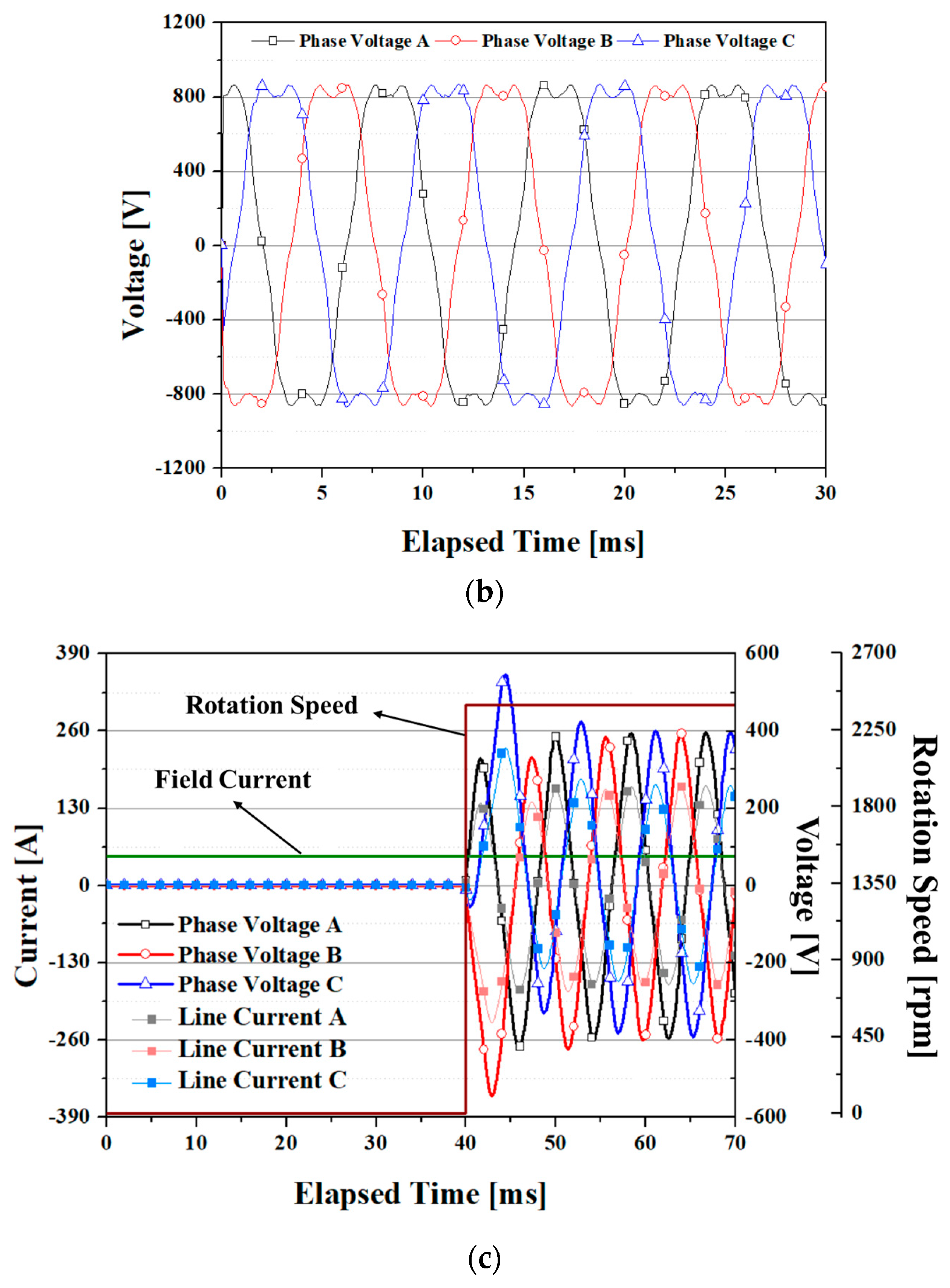
| Parameter | Coil I | Coil II | Coil III | Coil IV |
|---|---|---|---|---|
| Insulating type | Turn-to-turn insulation | No-insulation | Insulation every 8 turns | Insulation every 4 turns |
| Inductance | ~179 µH | |||
| Winding diameter | 65 mm | |||
| Winding turns | 40 turns | |||
| Critical current | ~74 A | |||
| HTS wire | 2G HTS wire (width: 4.8 mm, thickness: 0.19 mm) | |||
| Item | Value |
|---|---|
| Rated output power | 110 kW |
| Phases | 3 |
| Rated rotational speed | 2400 rpm |
| No. of poles | 6 |
| Outer radius of rotor yoke | 190 mm |
| Length of rotor yoke | 170 mm |
| Overhang of rotor yoke | 30 mm |
| No. of stator yoke slots | 18 |
| Depth of stator yoke slot | 103 mm |
| Width of stator yoke slot | 40 mm |
| No. of armature conductor per slot | 10 |
| Outer radius of stator yoke | 350 mm |
Publisher’s Note: MDPI stays neutral with regard to jurisdictional claims in published maps and institutional affiliations. |
© 2021 by the author. Licensee MDPI, Basel, Switzerland. This article is an open access article distributed under the terms and conditions of the Creative Commons Attribution (CC BY) license (https://creativecommons.org/licenses/by/4.0/).
Share and Cite
Hwang, Y.J. Design and Characteristic Analysis of a Homopolar Synchronous Machine Using a NI HTS Field Coil. Energies 2021, 14, 5658. https://doi.org/10.3390/en14185658
Hwang YJ. Design and Characteristic Analysis of a Homopolar Synchronous Machine Using a NI HTS Field Coil. Energies. 2021; 14(18):5658. https://doi.org/10.3390/en14185658
Chicago/Turabian StyleHwang, Young Jin. 2021. "Design and Characteristic Analysis of a Homopolar Synchronous Machine Using a NI HTS Field Coil" Energies 14, no. 18: 5658. https://doi.org/10.3390/en14185658
APA StyleHwang, Y. J. (2021). Design and Characteristic Analysis of a Homopolar Synchronous Machine Using a NI HTS Field Coil. Energies, 14(18), 5658. https://doi.org/10.3390/en14185658






